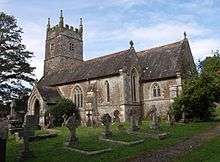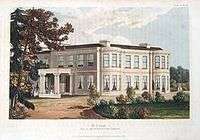Huish, Devon

Huish is a small village, civil parish and former manor in the Torridge District of Devon, England. The eastern boundary of the parish is formed by the River Torridge and the western by the Rivers Mere and Little Mere,[1] and it is surrounded, clockwise from the north, by the parishes of Merton, Dolton, Meeth and Petrockstowe.[2] In 2001 the population of the parish was 49, down from 76 in 1901.[1]
The village lies just off the A386 road, about five and a half miles north of Hatherleigh, and about seven miles south of Great Torrington. It was a member of the historic hundred of Shebbear and was in the deanery of Torrington.[3]
The majority of the parish consists of parkland belonging to Heanton Satchville, the seat of Baron Clinton;[1] the mansion-house is a few hundred yards to the north of the church.
Parish church
The church, dedicated to St James the Less, was heavily restored in 1873 by the 20th Baron Clinton to the designs of George Edmund Street, work described by Pevsner as "not of his best".[4] The 15th-century tower is the only part that remains unaltered.[5] The church contains a monument to John Cunningham Saunders, the noted eye surgeon who was born in the parish in 1773.[5]
Manor

In Kirkby's Quest, a survey of 1284–5, the manor of Huish was recorded as being held by Richard de Hiwis.[6] According to Tristram Risdon, writing in about 1630, Emma, the daughter of the last of this family, married Robert Tresilian who was Chief Justice of the King's Bench and after his execution in 1388 she married Sir John Coleshill. Risdon goes on to say that the land was purchased by Leonard Yeo who built a new house there, and his descendant, also Leonard Yeo, owned the manor in Risdon's own time.[7]
The manor remained in the Yeo family until it was sold by Edward Roe Yeo, MP, (died 1782) to John Dufty from whom it was purchased in 1782 by Sir James Norcliffe Innes, later 5th Duke of Roxburghe, who built a new house on the estate, which he called Innes House. He sold the manor to Richard Eales, from whom it was purchased in about 1812 by the 18th Baron Clinton.[3]
Clinton renamed the estate as Heanton Satchville, after the former family home at Heanton Satchville, Petrockstowe, which had burned down in 1795.[8] It remains the seat of the Barons Clinton.
References
- 1 2 3 Harris, Helen (2004). A Handbook of Devon Parishes. Tiverton: Halsgrove. p. 89. ISBN 1-84114-314-6.
- ↑ "Map of Devon Parishes" (PDF). Devon County Council. Retrieved 20 June 2013.
- 1 2 Lysons, Daniel; Lysons, Samuel (1822). Magna Britannia, Volume Six, containing Devonshire. London: Thomas Cadell. pp. 284–5. Retrieved 5 March 2012.
- ↑ Pevsner, Nikolaus (1989) [1952]. Cherry, Bridget, ed. The Buildings of England: Devon. Harmondsworth: Penguin Books. p. 497. ISBN 0-14-071050-7.
- 1 2 Hoskins, W. G. (1972). A New Survey of England: Devon (New ed.). London: Collins. p. 413. ISBN 0-7153-5577-5.
- ↑ O. J. Reichel (1914). "The Hundred of Lifton in the time of Testa de Nevil, A.D. 1243". Report & Transactions of the Devonshire Association. XLVI: 211.
- ↑ Risdon, Tristram (1811). Rees; et al., eds. The Chorographical Description or Survey of the County of Devon (updated ed.). Plymouth: Rees and Curtis. pp. 266–7.
- ↑ Lauder, Rosemary (2002). Devon Families. Tiverton: Halsgrove. p. 68. ISBN 1-84114-140-2.
External links
- Listed Building text, Heanton Satchville
- Listed Buildings text, Church of St James the Less
- Clinton Devon Estates website
Coordinates: 50°52′52″N 4°05′10″W / 50.881°N 4.086°W